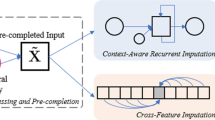Abstract
Missing values are common in clinical datasets which bring obstacles for clinical data analysis. Correctly estimating the missing parts plays a critical role in utilizing these analysis approaches. However, only limited works focus on the missing value estimation of multivariate time series (MTS) clinical data, which is one of the most challenge data types in this area. We attempt to develop a methodology (MD-MTS) with high accuracy for the missing value estimation in MTS clinical data. In MD-MTS, temporal and cross-variable information are constructed as multi-directional features for an efficient gradient boosting decision tree (LightGBM). For each patient, temporal information represents the sequential relations among the values of one variable in different time-stamps, and cross-variable information refers to the correlations among the values of different variables in a fixed time-stamp. We evaluated the estimation method performance based on the gap between the true values and the estimated values on the randomly masked parts. MD-MTS outperformed three baseline methods (3D-MICE, Amelia II and BRITS) on the ICHI challenge 2019 datasets that containing 13 time series variables. The root-mean-square error of MD-MTS, 3D-MICE, Amelia II and BRITS on offline-test dataset are 0.1717, 0.2247, 0.1900, and 0.1862, respectively. On online-test dataset, the performance for the former three methods is 0.1720, 0.2235, and 0.1927, respectively. Furthermore, MD-MTS got the first in ICHI challenge 2019 among dozens of competition models. MD-MTS provides an accurate and robust approach for estimating the missing values in MTS clinical data, which can be easily used as a preprocessing step for the downstream clinical data analysis.






Similar content being viewed by others
Notes
References
Luo Y, Szolovits P, Dighe AS, Baron JM (2018) 3D-MICE: integration of cross-sectional and longitudinal imputation for multi-analyte longitudinal clinical data. J Am Med Inform Assoc 25(6):645–653. https://doi.org/10.1093/jamia/ocx133
Choi E, Bahadori MT, Sun J, Kulas J, Schuetz A, Stewart W (2016) Retain: an interpretable predictive model for healthcare using reverse time attention mechanism. In: Advances in Neural Information Processing Systems, pp. 3504-3512
Xu X, Wang Y, Jin T, Wang J (2018) Learning the representation of medical features for clinical pathway analysis. In: International Conference on Database Systems for Advanced Applications, pp. 37-52. Springer
Xu X, Wang Y, Jin T Wang J (2018) A deep predictive model in healthcare for inpatients. In: 2018 IEEE International Conference on Bioinformatics and Biomedicine (BIBM), pp. 1091-1098. IEEE
Che Z, Purushotham S, Cho K, Sontag D, Liu Y (2018) Recurrent neural networks for multivariate time series with missing values. J Scientific reports 8(1):6085
Buuren SV, Groothuis-Oudshoorn K (2010) Mice: multivariate imputation by chained equations in R. J Stat Software, 1-68
Stekhoven DJ, Buhlmann P (2012) MissForest--non-parametric missing value imputation for mixed-type data. Bioinformatics 28(1):112–118. https://doi.org/10.1093/bioinformatics/btr597
Recht B (2011) A simpler approach to matrix completion. Journal of Machine Learning Research 12(Dec):3413–3430
Yoon J, Zame WR, van der Schaar M (2018) Estimating missing data in temporal data streams using multi-directional recurrent neural networks. IEEE Transactions on Biomedical Engineering 66(5):1477–1490
Cao W, Wang D, Li J, Zhou H, Li L, Li Y (2018) Brits: bidirectional recurrent imputation for time series. In: Advances in Neural Information Processing Systems, pp. 6775-6785
Luo Y, Cai X, Zhang Y, Xu J (2018) Multivariate time series imputation with generative adversarial networks. In: Advances in Neural Information Processing Systems, pp. 1596-1607
Honaker J, King G, Blackwell M (2011) Amelia II: a program for missing data. Journal of Statistical Software 45(7):1–47
Johnson AE, Pollard TJ, Shen L, Li-wei HL, Feng M, Ghassemi M, Moody B, Szolovits P, Celi LA, Mark RG (2016) MIMIC-III, a freely accessible critical care database. J Scientific Data 3:160035
Seeger M (2004) Gaussian processes for machine learning. Int J Neural Syst 14(2):69–106. https://doi.org/10.1142/S0129065704001899
Friedman JHJAOS (2001) Greedy function approximation: a gradient boosting machine. 1189-1232
Chen T, Guestrin C Xgboost: a scalable tree boosting system. In: Proceedings of the 22nd acm sigkdd international conference on knowledge discovery and data mining 2016, pp. 785-794
Author information
Authors and Affiliations
Corresponding authors
Ethics declarations
Conflict of interest
The authors declare that there is no conflict of interest.
Additional information
Publisher’s Note
Springer Nature remains neutral with regard to jurisdictional claims in published maps and institutional affiliations.
Rights and permissions
About this article
Cite this article
Xu, X., Liu, X., Kang, Y. et al. A Multi-directional Approach for Missing Value Estimation in Multivariate Time Series Clinical Data. J Healthc Inform Res 4, 365–382 (2020). https://doi.org/10.1007/s41666-020-00076-2
Received:
Revised:
Accepted:
Published:
Issue Date:
DOI: https://doi.org/10.1007/s41666-020-00076-2




